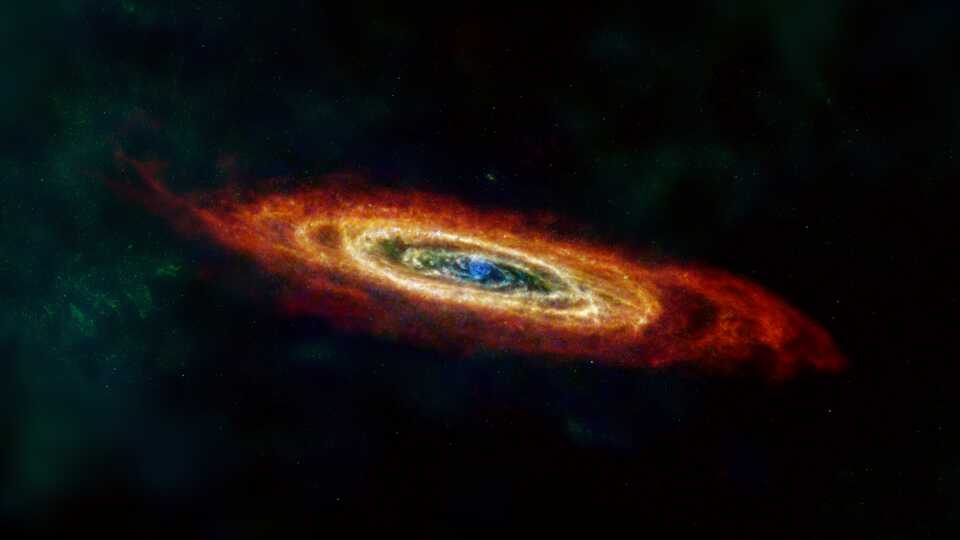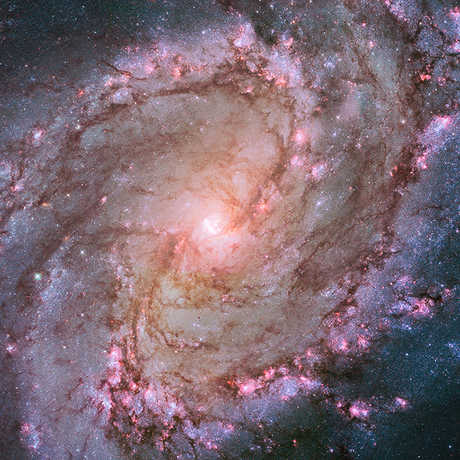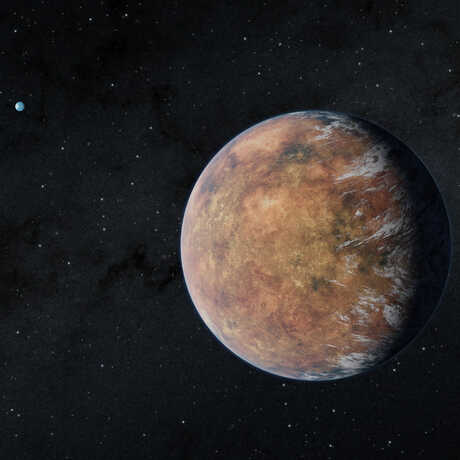Science News
Dusty Environments Near and Far

The Andromeda galaxy, or M31, is shown here in far-infrared and radio wavelengths of light. Credit: ESA, NASA, NASA-JPL, Caltech, Christopher Clark (STScI), R. Braun (SKA Observatory), C. Nieten (MPI Radioastronomie), Matt Smith (Cardiff University)
Dust! It’s not just collecting on your shelf, it’s the topic for the final press conference at the 240th meeting of the American Astronomical Society. So far, we have explored planets, planetary disks, and neutrinos during the week-long conference. Today we heard about the importance of dust both near and far in our Universe.
Dust is made up of tiny grains of silica material, and astronomers find it everywhere, including in between galaxies. Most of the time, it blocks our view of the visible Universe. About half of the visible starlight is absorbed by dust grains. Star and planet formation are made from dense regions of dust clouds—most of the time obscured from our view. Also, as Chris Clark, a post-doc at the Space Telescope Science Institute (STScI), explained, a significant fraction of heavy elements floating out in space—such as carbon, oxygen, and iron—are locked up in dust grains. So astronomers need to understand dust grains to understand galaxies.
One way astronomers observe dust is in far-infrared wavelengths of light, light our eyes can not perceive. Telescopes Herschel and IRAS observed this part of the spectrum, but they had limitations. As Clark explains, Herschel had fantastic resolution to observe small dense features in a galaxy, but it struggled to detect diffuse large scale dust in a galaxy. On the other hand, IRAS was fantastic at looking at these large-scale dust features but provided low-resolution imagery of the small scale features.
Clark and the team at STScI used advanced processing techniques to combine images from both instruments, allowing the astronomers to observe both the large and small scale features and to understand the entire life cycle of dust in galaxies. This technique had been done with radio telescopes but is demanding for infrared images. To help them create a complete picture, the team also added data from COBE and Planck satellites. The researchers used this method for five nearby galaxies, including the Magellanic Clouds. Looking at these galaxies, they then compared the dust to gas and found a massive variation of gas versus dust. Dust grains growing rapidly in dense clouds that are then destroyed in low-density environments is another clue in understanding galaxy formation.
At home, I try not to collect too many dust bunnies. But the western United States has our fair share of dust devils. No, not the Looney Tunes cartoon kind, but a vortex of wind picking up dust to create what appears like a tornado. These are short-lived, and Brian Jackson’s team at Boise State has been observing these dust devils in the west using drones. Yes, similar to Bill Paxton’s Dorthy instrument in the movie Twister (Jackson even admitted in today’s press conference that he wants to be Bill Paxton’s character in that film). The Boise State team flies their drones through the dust devils with sensors to determine how much dust is in the vortex.
From the many missions humans have sent to Mars, we know it is a dusty world with dust on the surface and in the atmosphere. But how does the dust get into the atmosphere? Jackson’s team thought maybe the multiple dust devils on Mars. The film The Martian got this right, Jackson explained. In the first 178 days the Perseverance rover spent on Mars, the rover detected 800 vortices using its MEDA’s Radiation and Dust Sensor. Since Perseverance's data is available to the public, Jackson went through MEDA’s data to determine if the vortices were dusty or not. They found only a fourth of the dust devils had significant dust presence, not enough to account for the amount of dust in Mars’s atmosphere.
Observing dust with telescopes or spacecraft is critical, but sometimes, scientists need to use a laboratory, too. Most of the molecules in space are simple, with only two to three atoms, such as water (H2O) and carbon monoxide (CO). Yet astronomers have found more complex configurations of atoms in space, including C60 and C70—spheres consisting of 60 or 70 carbon atoms! These complex carbon molecules, Buckminsterfullerene (or more familiarly, “buckyballs”), drift through the interstellar medium, the space between the stars, and have garnered significant attention. However, astronomers have struggled to understand how these molecules can form in space.
Jacob Bernal, a post-doc at the University of Arizona, went to the lab to test a theory. Their test included instantaneous heat—1,000°C—aimed at silicon carbide dust to see if buckyballs were formed. These are similar conditions to those found around dying stars. Bernal and the team observed they could create buckyballs at 1,000°C, and even more complex, highly structured rod-like molecules consisting of multiple layers of carbon sheets called carbon nanotubes when heating the dust to 1,050°C. From the lab test, their theory is that buckyballs and nanotubes form when the dust made by dying stars is hit by a shock wave from a supernova. These results are great news for astrobiologists. It provides a way to concentrate carbon that could be used for planetary systems and life.
While the dust in our house may be frustrating, astronomers continue to be fascinated by these dusty environments both near and far.


